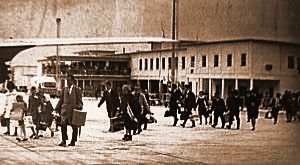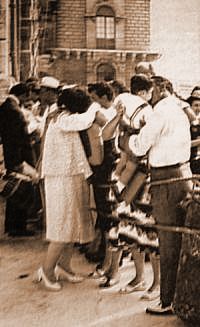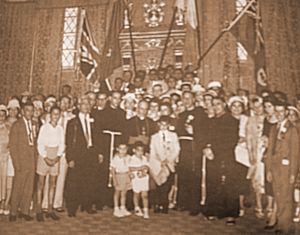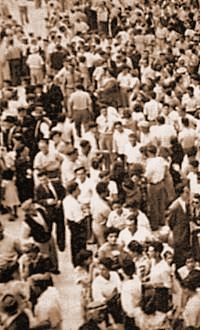Ajax Camp
Luqa airport - migrants leaving for Canada, 1969 In December 1950, George Bonavia, a Maltese journalist who had settled in Canada two years previously, was asked to visit a group of forty-five Maltese immigrants living in Ajax Camp. It transpired that this group was largely made of young men between the ages of eighteen and twenty five. They had been in the Camp for three months and they now clamoured to be repatriated. They said they were given jobs they did not like, that they had not been sending any money to their families in Malta and that they still owed money to those who had lent them money in order to emigrate. Their last complaint was that their clothes were not warm enough for the Canadian weather. (56) According to the Canadians the disaffected ones were very few. They also thought that some of them should never have been passed as migrants fit for Canadian conditions. They claimed that among those who were disaffected were a number of Maltese who had lived for some time in the U.K. and did not like it over there. To send failed migrants to another country was, according to the Canadians, a lowering of standards. On December 13, 1950, twenty-six Maltese still at Ajax Camp wrote to the British High Commission in Ottawa enumerating what they considered their main grievances. Again they claimed that since they were unemployed they had no money for themselves nor could they send any remittances home, they did not have good clothing for the winter and the jobs they were offered were not suited for them. The High Commissioner passed on their letter to the Canadian authorities. (57) Another letter was sent to Mr D. Mintoff, leader of the M. L.P., and to his deputy Dr J. Flores. This letter had twenty-nine signatures and besides the points mentioned in the other letter they also complained about the food and the offer of work they were given to go to Val d'Or to work in the mines. 
Heart rending scenes at the Customs House, Valletta Mr MacNamara, Deputy Minister of Labour, wrote from Ottawa on January 2, 1951, about the unrest in Ajax Camp. He singled two Maltese as the source of the trouble, the rest wished to take the jobs they were given but "rather foolishly went along with a few who denounced the wages as too low". Mr MacNamara did not deny the fact that the wages offered to the Maltese were relatively low, but he thought that for workers coming recently to Canada from a British colony such wages were adequate and compared very favourably with what they would have received had they stayed at home. (58) The situation in Ajax Camp was very embarrassing to the Maltese Government. Great efforts had been made to persuade the Canadians to open their doors to the migrants from Malta and now the results were being marred by contentions made by those same migrants. The Legislative Assembly debated the issue on December 18, 1950. Mr Axisa did his best to minimise the harm already done when he wrote to Ottawa: "One thousand men have been satisfactorily established in Canada since May 1948. They had nothing but praise for the wonderful hospitality, friendliness and helpfulness shown to them by the Canadians. This unfortunate episode must not mar the very good relations between our two countries". (59) Mr George Bonavia was under the impression that Ajax was only a transit camp and residents there should not be allowed to tarry for more than was strictly necessary. He described the Camp as a small temporary village with its own church, school and hospital. At the time of his visit he thought there were about eight hundred residents in all. All rooms were heated. There were also showers. Residents were expected to make their beds and clean their rooms. Mr Bonavia noted that the Maltese did not like doing their rooms because they said that back at home ttheir mothers, wives or sisters, alws that that for them. There were thre free meals based on a self-servic system. There was a common dining room and food was standard. Mr Bonavia thought that food was good and compared well with any served in an ordinary restaurant. It was naturally very different from what the Maltese were used to . Some Maltese complained that there was not enough bread. Mr Bonavia also noted that the Camp had a common recreation room and that there was a resident doctor. Mr Bonavia was not given a cordial reception by the Maltese. They thought they were capable of speaking for themselves and did not need any intermediary. He offered to meet them in private but at first they all refused and decided to ignore him A few did eventually communicate with him but the rest were only interested in being repatriated. (60) It could be argued that some of the men involved in the dispute should have never been sent to Canada. It was also undeniably true that a number of the Maltese were skilled workers used to work in factories and shops. They had never been down in a mine and few had had experience with open air work. Later on it was officially admitted that the residents in Ajax were not provided with clothing meant to protect them against the inclemency of the Canadian weather. The Canadians expected the immigrants to carry such clothes with them. It was admitted that the wages offered to some of the Maltese were inferior to those earned by workers doingthe same jobs. There was a major difficulty in the process of integrati ng the Maltese immigrant into the local work force. The difficulty had been only slightly referred to but never explicitly stated. Workers who were considered as skilled in Malta were not accepted as such by their Canadian employers. This was because an experienced worker considered himself as skilled, and very often he was, but he had never served a regular apprenticeship and hepossessed no certificates to prove his ability. (61) The Canadian system was to classify all immigrants as general labourers and then give them the chance to follow an apprenticeship in Canada which give them the status of a recognised skilled worker. 
Maltese Canadians on a visit to Malta, 1960 In spite of certain problems which received the city they did not deserve, the general impression made by those migrants from Malta, especially if they were soon joined by the rest of the family, was entirely positive. This is proved by what Mr R. St Vincent and Dr W.G. Burrows said the candidates they had examined. They thought that the Maltese were among the best migrants they had met because they had good manners, possessed enough English, and many had relatives or friends already settled in Canada. This made the Maltese not only good workers but also permanent settlers. Dr Burrows wrote: "The prospective migrants are in a very good condition. Their health is one of the best and I think that I can safely say that they are healthier than those I have examined in other countries". (62) The flow of Maltese emigrants to Canada reached its peak in 1951 when 1,607 entered the country. Only in 1964 and in 1965 did the total of Maltese entering Canada actually surpass the one thousandth mark. This made Canada the third most immigration country with the Maltese, after Australia and the United Kingdom. The increase in the number of migrants going to Canada was due to the softening of attitude adopted by Canadian immigration officials with regards to those who applied to emigrate from Malta to Canada. Post-war migration to Canada probably exceeded the total of 19,000 settlers. The Government of Malta encouraged this movement when it paid 75% of the fare. More financial help was coming after 1954 when the British Government also offered help which meant that the migrant was left to pay a mere £10, teenagers paid £5, and children travelled free. Also, when one emigrated on his own with the intention of sending for the wife and children at a later date, Maltese authorities offered allowances to the dependents left temporarily behind. About 70% of emigrants were able to go to Canada because they were sponsored by relatives who would provide accommodation and help to acquire jobs for the new arrivals. They would also help them to integrate into the new environment. Then there was also the Open Placement policy which helped those who wished to settle in Canada but had no one to sponsor them. Such candidates were chosen because of their skills or general aptitude. They were sponsored by the Canadian Government, which meant that on arrival they had temporary accommodation and they also had a job waiting for them. The Open Placement scheme came into operation, in so far as the Maltese were concerned, in 1957. The total number of emigrants to Canada in that particular year was 739 and of those some 300 entered the country under the Open Placement policy. This same policy helped to increase the number of successfully integrated immigrants because emphasis was made on the general health of the applicants, their conduct and their adaptability. The Canadians also determined the place of work and expected flexibility on the part of the migrant and to show willingness to accept the Canadian way of life. Prior to 1957 most of the Maltese who went to Canada did so because they had relatives or friends who were willing to help them. (63) The Emigration Department of Malta helped by providing an escort who would accompany migrants chosen under the Open Placement scheme. The first escort was Mr J. Tonna who stayed with the first group of 195 migrants until they were placed in the camp of St Paul I'Eremite. 
Relatives and friends accompanying departing migrants Although the Open Placement scheme was expected to boost the number of Maltese going to Canada, the large increase never materialised. The number of those selected without having sponsors for 1958 was one hundred twenty seven, while those for 1959 was one hundred and ten. In fact, the Emigration Report for 1960 called the Open Placement scheme a minor movement, even if in that year a slight increase was achieved when two hundred and twenty-two applicants were accepted. The report also noted that for the first time married applicants were allowed to take their families with them. (64) By 1961 Canada's immigration policy became even more restrictive and selective because of the rise of unemployment in the country. Even the choice of candidates under the Open Placement scheme was narrowed because the selectors would only interview people with special skills or professions, whereas in previous years they accepted clerical workers and even some with no particular experience in any given trade. (65) A significant change in Canada's regulations which defined who should be accepted as a permanent resident in the country came into being on February 1, 1962. Officially all forms of discrimination were erased from the books and the new criteria admission were to be education, training, skills and other special qualifications. The old considerations based on race, religion and country of origin were finally abandoned. (66) Maltese observes thought that such a development in mentality would prove beneficial. While in 1962 only three hundred and seventy-one Maltese were admitted into Canada, the figure for 1963 reached the total of nine hundred and five. More impressive still were the figures for the next two years: Year | Migrants | 1964 | 1,181 | 1965 | 1,113 (67) |
| |
However the Emigration Report for 1962 did strike a note of caution: "The new facilities that are being offered could only be exploited if prospective emigrants with the right education, training and skills will in future be available in ever increasing numbers an d that naturally will be in proportion to the efforts of the Administration towards more intensive education and technical training of the young". (68) In July 1964 any financial assistance accorded to those intending to leave for Canada was given only by the Maltese Government under the Emigration Assistance Scheme. From the Canadian side the prospective emigrant had to show that he had accommodation already provided and that his health and conduct were good. Luggage was to be paid by the migrant himself though concessions were made which allowed a certain amount of luggage to go free. Travel by sea was usually done by the Italian Line either from Palermo or Naples. In the early sixties the fare was about £64. Even then travel by air was becoming more frequent, thus on June 9, 1958, thirty emigrants left by air and within a week another one hundred flew either to Rome or to London to catch another flight to Montreal. These air travellers were destined for St Paul I'Eremite Camp in Quebec. (69) In 1964 R.A. Helling of the University of Windsor conducted a survey by mail of a sample of Maltese established in Canada. Helling's survey showed that as citizens of the British Commonwealth the Maltese faced fewer difficulties in starting a new life in Canada. Many were capable of conducting a conversation in English even if at home they still preferred to speak Maltese. This helped them to mix freely with other groups and their children tended to speak English rather than Maltese. The bulk of the Maltese population was to be found in Toronto, though smaller groupings were to be found in Hamilton, Mississagua, Oshwa, Ottawa, Windsor and London. Even smaller groups were to be found in British Columbia, Manitoba and Quebec. Helling found out that most Maltese immigrants had entered Canada when they were under thirtyfive years of age. They made good settlers because most of them were helped by other Maltese who had settled in the area before. Most were married to Maltese partners. The majority had entered Canada since 1948 and had been successful in integrating themselves into the economic and social fabric of the local community where they had established themselves. Helling's survey showed that more than 60% of the new arrivals were able to find employment within the first week of their arrival. Most of them were of the opinion that by living in Canada they had improved their socioeconomic status. They considered themselves as Canadians of Maltese origin. (70) Source: The Safety Valve (1997), author Fr Lawrence E. Attard, Publishers Enterprises Group (PEG) Ltd, ISBN 99909-0-081-7
    
| 

![]() .
.